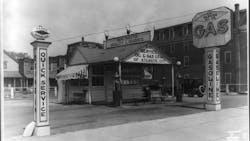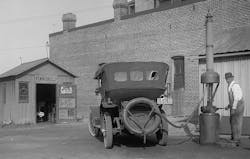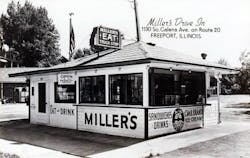Lagging nationwide charging infrastructure development has been an argument against the widespread adoption of zero- and low-emission vehicles. Electric vehicle owners might experience range anxiety when they don’t know where they can recharge next. A fleet owner who exclusively uses propane autogas might not have any public filling stations in their area. While range anxiety might feel new and alt-fuel filling stations appear few and far between, society has been here before.
In 1905, the Federal Highway Administration reported there were 77,400 registered automobiles on the roads. But the first traditional drive-in gas station wasn’t established until eight years later in 1913 in Pittsburgh, Pennsylvania, selling “Good Gulf Gasoline,” a Safe Rack article notes. There were several years between the first vehicles sold and the widespread establishment of the gas station.
See also: Where alt-fuel infrastructure stands today: hydrogen, RD and biodiesel, and natural gas
How early motorists got fuel
Around the time Ford Motor Company found success selling its Model A, motorists purchased gasoline in cans at general stores, blacksmith shops, and even pharmacies, according to the Smithsonian Magazine.
At the earliest filling stations—some say the first was established in 1905 in St. Louis, while others say it was Seattle in 1907—the National Association of Convenience Stores reports that shopkeepers filled cans with gasoline from larger 5-gal. cans behind the store and brought it to the customer’s car to fill it.
To combat range anxiety during the early days of gasoline-powered vehicles, some motorists installed compartments on their vehicles that held extra gasoline cans.
At the time, no bulk fuel tank trucks delivered gasoline to these early 20th-century retailers. Petroleum was mostly delivered to these stores and stations by hoof, with horse-drawn "tank wagons” that carried fuel containers on the back. In 1905, Anglo-American, a subsidiary of Standard Oil, developed the first motorized tanker truck, Specialty Fuel Services explained. Tank trucks were popular ways to transport fuel in urban areas in the 1910s, according to the Petroleum Service Company, while horse-drawn buggies continued hauling fuel in rural areas until the 1920s.
See also: Where alt-fuel infrastructure stands today: EV charging infrastructure
The gasoline station is born
The story of the gasoline pump begins in the 1880s in Fort Wayne, Indiana, when S.F. Bowser sold his kerosene pump invention to a local grocery store owner. Bowser’s device—complete with marble valves, wooden plungers, and upright faucets—“reliably” measured and dispensed kerosene, according to the American Oil & Gas Historical Society. After the machine proved successful at the grocery store, Bowser patented his design and formed his own pump manufacturing company.
Bowser’s kerosene pump was designed to dispense kerosene as well as “burning fluid and the light combustible products of petroleum,” the AOGHS article states. As the demand for gasoline grew, so did the success of Bowser’s company. By 1905, Bowser modified the pump to accommodate a hose attachment for dispensing directly into vehicle fuel tanks.
As automobiles gained popularity with the American people, the demand for gasoline grew, causing filling stations to pop up on curbsides across the nation. By 1913, Gulf Oil’s General Sales Manager W.V. Hartmann wanted to build a Gulf-branded station “to rise above all others,” according to the Heinz History Center in Pittsburgh.
Construction on the Gulf gas station began on a triangle-shaped plot of land in 1913. The pagoda-style structure required a cantilevered roof to cover 13 Bowser Red Sentry gasoline pumps and a concrete platform for the pumps. Four attendants were hired to man the station.
To bring more customers to the station, Frank McLaughlin, the station’s manager, offered free services, asking customers to “tell their friends” in exchange. Services offered included oil changes, radiator fills, filling tires with air, and no labor charges on repaired tires and tubes. “Like Gulf management, McLaughlin wanted it to be, as he said, ‘a service station,’” Heinz History Center explains.
Because of the station’s success, competitors began springing up all over the area, and soon, all over the U.S. More than 110 years later, the NACS reports there are roughly 145,000 fueling stations in the U.S., with 127,588 categorized as convenience stores.
See also: What are EV truck charging stations’ needs?
Diesel is introduced; truck stops are established
Although the diesel engine was invented in the 1890s by German engineer Rudolf Diesel, diesel engines were not used in trucks or automobiles until much later. In its early years, the diesel engine was primarily used in factories or as generators, according to Biltmore Oil, but eventually, European countries preferred the engine for their seafaring military operations.
In 1923, Benz & Cie. (which would become Mercedes-Benz) debuted the first diesel-powered truck. It achieved 86% better fuel efficiency than its gasoline-powered counterparts, according to Daimler Truck, now the parent company of Mercedes-Benz. Daimler Truck introduced its own diesel truck that same year. The companies merged in 1926 and launched the six-cylinder OM 5 engine. The Mercedes-Benz L5 was fitted with a diesel engine and went into production in 1928.
Across the pond that same year, Clessie Cummins, who founded the engine manufacturing company, Cummins, developed the Model U diesel engine and would later send it on a successful cross-country trip from New York to Los Angeles, highlighting the efficiency of diesel fuel. It was Cummins who convinced a grocery store owner to install diesel engines in his grocery fleet, which proved more efficient and economical.
See also: What's new in Cummins' next diesel X15 engine
Diesel engines were used in some consumer vehicles and commercial vehicles by the 1930s, but it wasn’t until World War II, when gasoline became more scarce, that the commercial trucking industry shifted to diesel fuel, according to vehicle guard company, Herd.
After the war, tractor-trailers grew in popularity. In the 1950s and 1960s, intermodal shipping became popular and tractor-trailers were loaded onto flat railroad cars, shipped across the country, and unloaded to be driven to their destination, Herd explains.
The trucking industry continued to grow, and now employs 8.5 million individuals in various roles within the industry, according to the American Trucking Associations—this excludes those who are self-employed.
Those cross-country and cross-region trips required truckers to rest on the road. First established in the 1920s and 1930s, truck stops provided basic amenities, such as a restroom, fuel pumps, and a diner, according to an article from Bloom Services, a transportation company.
After WWII when the trucking industry expanded, so did truck stops. They provided laundry facilities, showers, and even a place for truckers to sleep.
Bloom Services describes the 1950s and 1960s as the “golden age” of truck stops. Truck stops during these years offered amenities such as “restaurants, motels, convenience stores, and more. They were designed to meet the needs of truckers and provide a comfortable and convenient place to rest during long hauls,” the article states.
Truck stops have only grown since, and some have even called them “travel centers,” as they offer a variety of necessities for both motorists and truckers traveling across the nation.
Infrastructure follows adoption
History shows us that in the “chicken or egg” dilemma, it was the vehicle adoption that came first and infrastructure development that followed.
Registrations of gasoline-powered vehicles doubled in the first few years after these vehicles were available to the public—even without infrastructure development. Fast-forward to today, EV adoption has also grown, with Recurrent, a startup that helps evaluate used EV batteries, predicting EV adoption to reach “the 15% Mass Adoption Phase by the end of 2025.” Alternative-fuel vehicle adoption has also grown, especially among fleets, according to the Environmental Protection Agency.
While infrastructure is still a hurdle to widespread EV and alt-fuel vehicle adoption, much like with oil and gasoline infrastructure, it can be accomplished through innovation and planning.
About the Author
Jade Brasher
Senior Editor Jade Brasher has covered vocational trucking and fleets since 2018. A graduate of The University of Alabama with a degree in journalism, Jade enjoys telling stories about the people behind the wheel and the intricate processes of the ever-evolving trucking industry.



